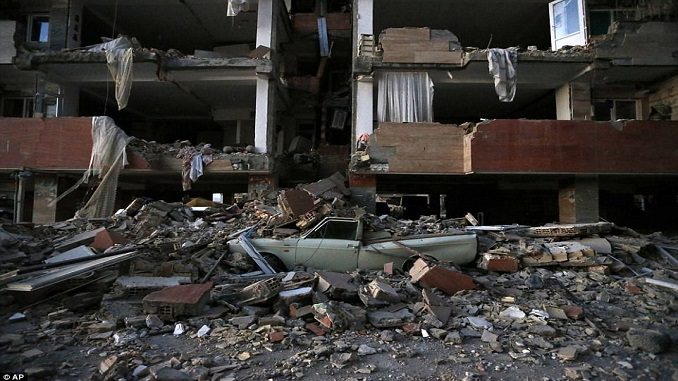
More than 339 people were killed and at least 2500 were injured in Iran on Sunday when a powerful magnitude 7.3 earthquake hit the country, state media said, as rescuers stepped up efforts overnight to find dozens trapped under rubble. Most of the deaths were reported in Iran’s Kermanshah province on the Iraqi border, the provincial deputy governor told state television, Al-Arabiya reports.
“There are still people under the rubble. We hope the number of dead and injured won’t rise too much, but it will rise,” Mojtaba Nikkerdar said.
The epicenter of the quake, which occurred at around 09:18 pm local time on Sunday, was 32 kilometers south of the Iraqi city of Halabja, in Iraqi Kurdistan, and just across the border from Iran, according to the United States Geological Survey (USGS). But the highest casualties occurred in the town of Sarpol-e Zahab, in Iran’s Kermanshah Province.
On its website, the USGS placed the quake’s epicenter at about 18.6 miles southwest of the Iraqi city of Halabja. The USGS also issued an “orange” alert for “shaking-related fatalities and economic losses.”
“Significant casualties and damage are likely and the disaster is potentially widespread. Past orange alerts have required a regional or national level response,” the agency said online.”
The quake struck at a depth of 14.4 miles, a shallow depth that can have broader damage. According to the National Disaster Management Organization of Iran, 328 people were confirmed dead as of Monday noon. Some 2530 others were injured.
Soon after the quake occurred, Leader of the Islamic Revolution Ayatollah Seyyed Ali Khamenei issued a message calling on all Iranian officials and institutions to “rush to the aid of those affected in these early hours [after the incident].”
The Leader said the country’s entire range of capabilities had to be used swiftly to prevent a further rise in the death toll. Ayatollah Khamenei called on Iran’s Armed Forces to help with removing the rubble and transferring the injured to medical centers.
Separately, Iranian President Hassan Rouhani spoke on the phone with Iranian Interior Minister Abdolreza Rahmani-Fazli on Sunday night, who briefed the president on the latest updates. President Rouhani then issued the necessary directives to facilitate and accelerate rescue operations.
Kermanshah has announced three days of mourning. The earthquake was felt in cities in several other Iranian provinces, including as far away as in the capital, Tehran. Seven people died in Iraq, where people fled into the streets in the capital, Baghdad. Mosques in the city have been broadcasting prayers through loudspeakers.
“I was sitting with my kids having dinner and suddenly the building was just dancing in the air. I thought at first that it was a huge bomb. But then I heard everyone around me screaming: ‘Earthquake!,” a Baghdad mother-of-three, Majida Ameer, told Reuters news agency.
On the Iraqi side, the most extensive damage was in the town of Darbandikhan, 75km east of the city of Sulaimaniyah in the Kurdistan Region.
“The situation there is very critical,” Kurdish Health Minister Rekawt Hama Rasheed told Reuters.
The Iraqi ministry of health said 321 people had been wounded in the Iraqi Kurdistan region. The BBC’s Rami Ruhayem, in the regional capital Irbil, said shaking there lasted for more than a minute.
“For a few seconds at first it was barely detectable, I wasn’t sure whether it was a minor tremor or just my imagination. But soon enough it was unmistakable as the building started swaying from side to side,” he said.
Iraq’s Meteorological Organization issued a warning on Iraqi State TV urging citizens to stay away from buildings and to refrain from using elevators.
Iraqi Prime Minister Haider al-Abadi tweeted Monday that he has “instructed civil defense teams and health and aid agencies to do all that they can to provide assistance” to those affected by the quake. Seven people were killed and 301 injured in the Kurdish region of Iraq, according to Rekawt Hama Rasheed, the health minister of the Kurdish Regional Government. Rasheed said most of the injuries were minor.
At least four were killed in Darbandikhan, where a dam was hit by falling rocks. Rahman Shikhani, the head of the Darbandikhan Dam told CNN that cracks were spotted in the upper part of the dam but there was no water leakage. Shikhani said a specialized team was working on assessing the damage to the dam and begin repairs. Residents in nearby areas were told to evacuate in case there were more tremors.
Shocks were also felt in Pakistan, Lebanon, Kuwait and Turkey, news agencies in those countries reported.
